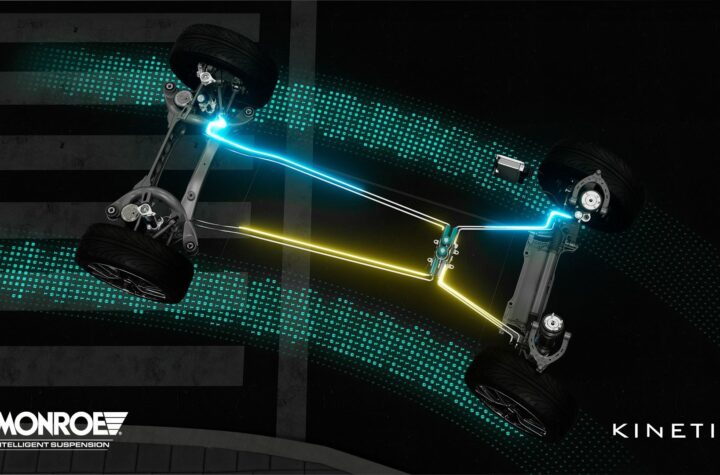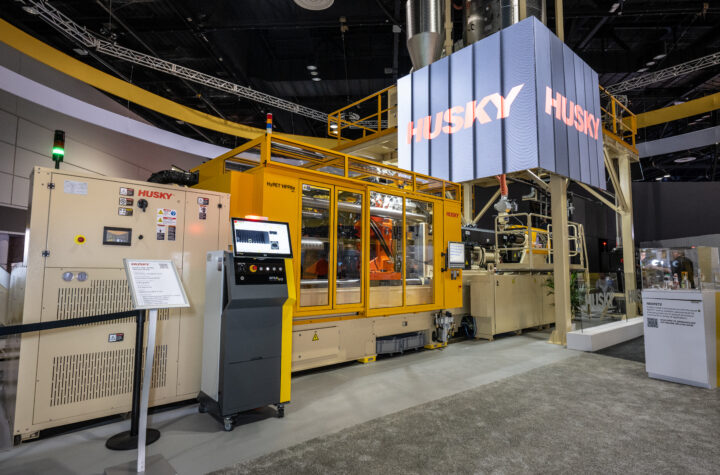At a recent International Press Briefing held at the company’s vehicle testing facility in Boxberg, Germany, Robert Bosch GmbH demonstrated its latest product and development projects in both gasoline and diesel fuel injection systems. On the diesel side, May 2003 saw the launch of Bosch’s third generation common rail system using compact, rapid-switch piezoelectric inline injectors.
 |
| Bosch’s new piezo-electric diesel injector switches in less than ten thousandths of a second. It uses a package of several hundred very small, thin crystals in an actuator integrated into the injector body. Movement is transferred to the rapid-switch nozzle needle without friction. |
In addition, the company is aiming, in 2005, to introduce an improved variable injector nozzle, intended to make diesels quieter and cleaner, as well as working on solutions for the exhaust emission treatment systems which will become obligatory for some cars and commercial vehicles.
“In Bosch’s conventional Common-Rail system the injector is controlled by a magnetic coil,” Dohle explains. “In the new piezoelectric injectors, we exploit the expansion of piezo crystals in an electrical field to produce an injector actuation effect switching in less than ten thousandths of a second, less than half the time required by a magnetic switch. A package of several hundred very small, thin crystals is used.”
To exploit piezo technology, Bosch has integrated the actuator into the injector body. The movement of the piezo package is transferred to the rapid-switch nozzle needle without friction. “There are no mechanical components,” Dohle confirms. “The advantages over magnetic and existing conventional piezo injectors lie in a more precise dosing and an improved atomization of the injected fuel within the combustion chamber. The higher switching speed of the injector means that the intervals between the individual fuel injections can be reduced, giving a more flexible control of the injection process.”
 |
| Making diesels quieter and cleaner: in 2005 Bosch is looking to introduce an improved variable injector nozzle. |
“The low tolerances for injection quantity and timing mean that the fuel dosage at the injector is very exact. This results in lower levels of exhaust pollutants. For example, one or two pre-injections of fuel prevent the emission of white and blue smoke just after a cold start and combustion noise is reduced. A supplementary injection following immediately on the main injection lowers the emission of soot particulate and a further injection can regenerate particulate filters, if fitted.”
Overall, Dohle states, Bosch’s third generation Common-Rail system with piezoelectric inline injectors is capable of reducing engine exhaust emissions by up to 20 percent compared with existing magnetic or piezoelectric systems. Dohle notes that in 2006 Bosch is planning further common rail innovations. Ideas under consideration are injection pressures of over 2000 bar and injectors with variable injection geometry.
On the gasoline injection side, Dr. Rolf Leonhard, vice president development, Gasoline Systems Division looked back on an involvement which started in 2,000 in the form of the DI-Motronic electronic gasoline direct injection system.
“With its stratified charge technology, DI Motronic has reduced fuel consumption by about 10 percent compared with port fuel injection systems,” Leonhard notes. “In the future, additional DI-Motronic features are set to make gasoline engines even cleaner and more fuel efficient.”
 |
| Injection methods for gasoline engines with Bosch’s DI-Motronic gasoline direct injection equipment. |
Exceptionally Low Emissions
“To achieve exceptionally low emission levels Bosch has developed gasoline direct injection with exclusively homogenous mixture formation for exhaust gas treatment using commercial three-way catalytic converters. “This allows current gasoline engines to meet the much tougher U.S. emission regulations which will be introduced in future,” Leonhard states. “Both engine manufacturers and their suppliers are currently investigating ‘jet-directed combustion’ as a further development of stratified charge gasoline direct injection. It will make gasoline engines even cleaner and more fuel efficient, because the fuel will be even more efficiently burnt than before. Special injection valves necessary for the new combustion process are being developed.”
Bosch is also working on a combination of DI-Motronic and turbocharging which is expected to bring much nearer the ideal of high engine performance and fuel economy already common in modern turbocharged DI diesels. “Since fuel injected directly into the cylinder cools the combustion mixture, this can be compressed even more than currently possible with supercharged engines, without the mixture self-igniting in an uncontrollable way,” Leonhard states.
“In addition, direct injection optimizes combustion by dividing the full load quantity of injection fuel into two parts. Taken together, these two measures improve efficiency across the entire operating range of the engine and reduce fuel consumption by around 3 percent.”
For engines with port fuel injection, high exhaust gas temperatures have a significant influence on turbocharger design. “Thus it is frequently not possible to achieve optimal implementation of other desirable features such as good responsiveness of the turbocharger to changes in loading, high engine performance and low fuel consumption.
“By contrast, engines with direct injection have lower exhaust gas temperatures, allowing engine developers greater scope to match the turbocharger system to these other goals,” Leonhard notes.
As previously stated, the combination of direct injection and turbocharging would be the basis of engine downsizing, which promises further reductions in fuel consumption. “A 30 percent reduction in cylinder capacity compared with a standard non-supercharged engine with throttle body injection can produce a reduction in fuel consumption of up to 14 percent without any comparative loss of power,” Leonhard says.
Aftertreatment, Start-Up
 |
| A clever trick with gasoline direct injection: direct engine start, somewhat in the fashion of a cartridge starter in aero engines. |
“Bosch has now achieved on direct injection systems with its well proven system for rapidly heating the catalytic converter with hot exhaust gases, previously only proven for port fuel injection,” Leonhard states. “By splitting the injection between the intake and compression strokes (homogeneous split dual injection), during the engine warm-up period the combustion mixture can be ignited significantly later, without risking uneven running of the engine or ignition failure. Very hot exhaust gases are produced, which heat the catalytic converter to its operating temperature twice as fast as normal.”
Spray guided combustion process
Bosch is also further developing the DIMotronic system with stratified charge to create a so-called “spray guided combustion process,” aimed at making gasoline engines both cleaner and more fuel efficient. In the new system, an injector jet is sited centrally in the roof of the combustion chamber, spraying fuel into the cylinder in such a fine stream that the fuel-air mixture can be ignited immediately.
“Current methods of gasoline direct fuel injection which typically have the mixture flowing along the cylinder wall and/or carried along by a stream of air can be dispensed with,” Leonhard explaines.
“The energy and thus the fuel required to produce strong flows of fuel mixture is saved and better heat insulation between the burning fuel mixture and the cylinder wall produces further increased levels of efficiency. Overall, DI-Motronic with the spray guided combustion process produces fuel consumption savings of a further 5 percent compared with current direct injection methods.” Bosch expects that it will be 2006 before the new combustion process is introduced.














































 Badge Re-engineering
Badge Re-engineering



